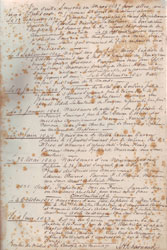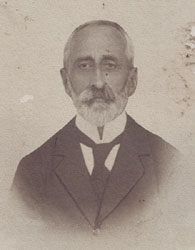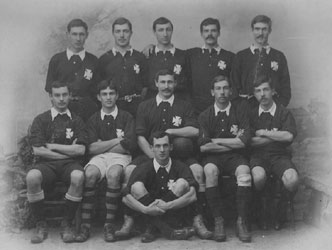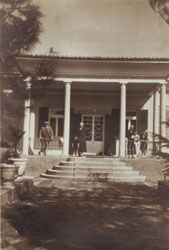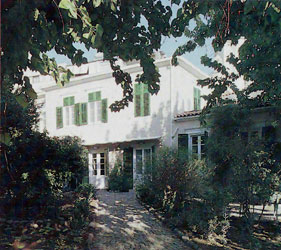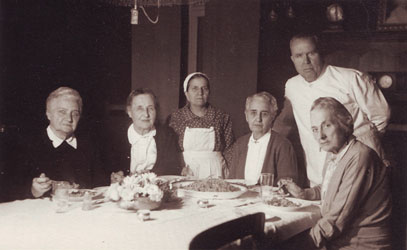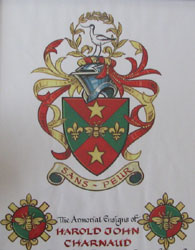I lived in Izmir and Bornova (Bournabat) until I was twelve years of age, when I went to school in 1961 to Edinburgh, Scotland. Whilst in Izmir, I went to the Brothers Roman Catholic School, St Joseph (as the only Protestant) and learnt fluent French and Turkish. I was also taught by the one and only Miss Estelle! I retain close links with Turkey and still speak the language.
When an expat returns to his or her home country there is an inevitable dilution for future generations of the very special essence of our amazing Levantine background. My parents retired to Great Dunmow, England in 2000. I greatly value this study recording this unique heritage.
The Charnaud story goes back to France, as Protestants they were amongst the persecuted having to flee for their lives like 100 of thousands alike, seeking a county of sanctuary. So shortly after the Revocation of the Edict of Nantes (revocation took place in 1685), Jean Samuel Charnaud (a direct ancestor of mine, 8 generations back) fled Pont de Veyle, near Bresse in Eastern France for Switzerland. I know nothing of what the family did as a living in France, or of his ancestors. Jean Samuel settled in Vevey in Switzerland, with his many sons and daughters (8 children, I am descended from a middle offspring, Pierre Samuel 1696-1746). Again I know nothing of what the family members did as an occupations in this country. From the same old family tree, I know again that Pierre had 5 sons, 3 of which died young, and a middle son, Jean born 1725 who went either alone or with his father to England and at some point and became a naturalised British subject in 1762, by special act of parliament as it was required in those days.
It was Pierre’s son Jean Charnaud who went to the Levant, we do not know when, and became a ‘factor’ of the British Levant Company that had a monopoly of trade conducted between England and Turkey. I do not know how this came about, put perhaps the Levant connection went back earlier, as Vevey was also the temporary residence of other families of French Huguenot refugees1, who also ended up in the Levant, so perhaps there was some sort of support / information network. The connection and vague family knowledge of the Levant and its ‘riches’ could go back to the Crusades, who knows? Jean married a Margaret Rosalie. I do not know if she came from Switzerland or they met in Smyrna [archive views], where he eventually died in 1773. Jean had three children, Francis who became the H.M. Consul at Smyrna and a member of the Levant Company in 1791. Other children were James and John, the latter being my ancestor, five generations back. Following the start of this study however, the family story of Consul of Smyrna did not match historical records, and it seems that he in conjunction with his brother James were British Consuls in Salonica [postcard views].
My ancestor John Charnaud, born Smyrna 1770, died in Alexandria 1827, and like his father had become a factor in the Levant Company. He married the Smyrna French Levantine Adelaide Couturier in 1805. His eldest son, John Henry, presumably also a factor, was posted to the remote Black Sea port city of Trabzon [postcard views], in 1837 as stated in the family bible, presumably to act as a buying agent for the different products of the region could offer (tea plantations would be started a century or so later, so hazel nuts, pistachios, lumber etc.?), and he stayed till 1851 (14 years) in this city where a few of his children were born (he married in 1839). Interestingly John Henry Charnaud’s sister, Adalaide married the British Consul in Trabzon, Frank Stevens, so perhaps she made her way to that port city as their father died in 1827 in Alexandria, chosing him amongst 4 brothers for economic support. John Charnaud had six more children, the middle child Frederick being my direct ancestor. Frederick married the Smyrna Levantine Mary Marraccini. Frederick Charnaud died in 1886. Frederick had four children, the eldest also named Frederick was my direct ancestor (great-grandfather), who married the British Smyrna Levantine family offspring, Dermina Borell, whose family we know through another descendant’s contribution (Andrew Malleson).
My earliest recollection of being in Bornova and being alive was when I was a baby sitting on the lap of my father Harold JOHN Charnaud playing with the volume knob of a radio, and getting a shock when the sound increased. This was in our upstairs flat in the Edwin Charnaud house in Bornova, on the outskirts of Izmir. My grandmother Phyllis was very much the matriarch of the family and lived in her house across a small square from us. Her house was an extended household where aunts and other single ladies also resided. These included my aunt Hilda (spinster), my aunt Winnie (Winifred de Cramer) as well Madeleine Whittall (spinster). Kazım the cook lived in a flat in the cellar and a Cretan nurse Anastasia lived in her room in the staff quarter. Granny Phyllis lived as a widow from 1950 when my paternal grandfather Harold Irwin died of a brain haemorrhage whilst combing his hair in the bathroom. Grandpa Harold was the factory manager at the Giraud basma (textile printing)factory in Izmir. His factory workers carried his coffin from St. Magdalene’s church to the Bornova Anglican cemetery, where all my family are buried. I was a babe in arms and cannot recall ever seeing him. Aunt Winnie had lived as a widow with Granny after her husband Fernand de Cramer died. Winnie, through Fernand had been befriended by Schliemann the famous German archaeologist who discovered Troy. Schliemann gave Aunt Winnie a fabulous example of Rhodian embroidery as a thank you for their hospitality.
After a short time my parents moved to the İkinci Kordon in Karşıyaka, Izmir in the ground floor flat of a block owned by my maternal grandfather Giovanni Galizzi. At the time my maternal grandfather lived in Karşıyaka but had previously originated from Palermo Sicily and my maternal Grandmother from an Italian Levantine family who had been fabulously wealthy and owned large areas of Rhodes and lost it all in the nationalisation of ‘Italian’ lands there after the Second World War. As they grew older they moved to the upstairs flat in Izmir. I was lucky that way to get to know all my remaining grandparents very well. My maternal grandmother Elizabeth (nee Prelorenzo) one of the best cooks a child can know (her fried calamari was enough to start a stampede of dinner guests), died first of liver cancer. We then moved back (1961) to Bornova and rented the butchers house, in the square on the other side of my Grandmothers house to the one we first lived in, next to the Baladour house (where Denise (nee Baladour) and Remo de Andria lived after Mr Baladour had died there) and where Geoffrey and Audrey Maltass lived. This house was my favourite as I had my own flat in the basement. It also coincided with the welcome birth of my brother Edwin Matthew twelve years my junior. I was by this time at school in Scotland and dreamed of this idyllic home. Sadly my grandfather, Giovanni Galizzi, soon died of a broken heart, never quite having got over the loss of his beloved wife, a part of whom is clearly imprinted in my DNA.
My earliest childhood memories were of playing with my best chums Philip and Herbert Whittall (sons of Victor and Mary Whittall), Martin and Max (Junior), sons of Max Steinbuchel and Renee nee Mattheys. Also in our group of pals were Jeanny and Alain Winterhalter (parents Nicky and Yvonne, nee Balliani), Lucien Arcas, June Whittall (daughter of Douglas and Susan Whittall) - view some of these.
Summers were spent in Lidja, now known as Ilıca near Çesme, in various rented houses on the Terrace or in my aunt Winnie’s house which had a magnificent jetty (skala) overlooking the majestic mountain at Karareis with its own thermal hot water spring where you entered the sea down the steps. Summers were spent skin-diving for fish in the morning, eating vast lunches, a siesta, and then a ‘sweat’ (a hard walk) on the hills behind Lidja, shooting partridges on the scrub hills. One had little time to play in the evenings as we were exhausted. What was of great interest was that as various nationals, we all spoke a private, lingua franga of a composition of any words from at least five (English, French, Turkish, Italian, Cretan Greek) languages. Whichever word was best to express the moment. I recently discovered that my Greek which was difficult to understand or make understood in Athens made immediate and complete sense in Crete on a recent visit, even to the degree of my accent.
I have some apocryphal stories of my ancestors, one of which was that my great, great, great something grandfather was kidnapped by brigands outside Bournabat and a ransom was only paid by the family when an ear was sent to them. I do not know if it was his ear that was sent... Also my Grandmother Phyllis who always gave lunch on Sundays to the padre who came for the Sunday service, was overheard telling him that she had gone the day before to ‘Paradise’ to see a Mrs Icard. The new padre seeing that granny was in her eighties and could have been on the way to losing the plot, humoured her saying that most good people visited Paradise, even sometimes before the main event. Granny was quite adamant of her visit and talked about the traffic etc., and the final denouement was when ‘Paradise’ was discovered to be, for the new ‘English’ vicar, an anglicized version of Paradiso a quarter near Buca to the southeast of Izmir... My great grandfather Fritz was an awful shot and on one occasion his chums bribed a man with dead partridges to give them to Fritz who claimed them as his bag. Regrettably for Fritz they each had a bit of paper in their beaks, saying Fritz shot me....
Asking my aunt (Edith Sell nee Charnaud) about Fritz Charnaud, I learnt the following information: ‘Apparantly his wife Dermina died when the children were still quite young. Ethemia was the nanny/housekeeper who brought up the children. He eventually married her and settled in Athens after the fire of Smyrna. During the fire he remained in Bornorva to look after the house after Harold joined Phyllis in Cyprus then Egypt to stay with Aunt Gladys. The tombstone in Athens shows Fritz with Ethemenia - view his tomb here:, his children later moved to other countries (Sidney to South Africa, Ivy to Italy, Mary to Lebanon, Harold Irwin stayed in Izmir/Smyrna and worked at the Pamuk Mensucat cotton factory owned by the Girauds). Dermina Charnaud is buried in the Bornova cemetery who died in 1890 aged 29 who was Dermina nee Borrell, his first wife.
At the time of the great fire of Smyrna which started on the 13th of September 1922 my grandfather Harold Irwin wrote from our house in Bournabat (25 Kazakoğlu Sokak) to his wife Phyllis a letter [view] on the 7th September, two days before the Turks entered the town and Turkish officers billeted into our house, describing the refugees and defeated Greek soldiers retreating in a scene of complete chaos. Meanwhile my Grandmother, her children Edith, Olive and my father John, (Betty was not yet born) had gone to Cyprus on a ferry boat they rented to stay with relations2.
Sometime in the 1930s my grandfather Harold Irwin caught a burglar in our house in Bornova and was going to call the police. The man was desperate and asked my grandpa not to, as he and his family were starving and he was doing his best to provide food for his wife and kids. My granpa then gave him a gold pound and told him never to commit a crime and do anything he could to earn an honest living. About 40 years later my aunt, who now lived in the USA (my grandpa’s daughter) was coming to Bornova to see her widowed mother and took a taxi from the airport to the house. On arival she asked the driver to wait a minute whilst she got some money from inside, but the driver first asked her who she was. When she told him he flatly refused to take the fare and told her the story of what he had done and how kind my grandfather had been. None of us knew of this and could not ask him as he had been dead a long time. ‘Ah! the milk of human kindness’.
It seems difficult to accept that my grandmother Phyllis was the last of us to be born, live and die in Bornova. It is so final for a great family adventure full of hope and expectation. My parents came to England in 2000 to retire. Their health was beginning to fail and they wished to live close to their new enlarged families of my brother and my own. Both my parents died and are buried in the cemetery in Bornova. I have a complex relationship with my ancestral roots in Turkey. I hold no particular wish to return to live there as I feel completely at home and at ease in England, but I often allow my mind to wander back to my old haunts, houses and adventures I had so many years ago. I still visit Izmir, Bornova and Lidja as a sort of pilgrimage and love to eat the local foods and sit at sunset on the quay in Izmir watching the sun go down on the Western horizon with a beer in my hand and thinking others like Homer before me may have done the same. If readers to this personal account have information to add to my ‘potted’ history, please contact me at Harry.Charnaud[at]Googlemail.com.
Çok selam.
The Charnaud house in Bornova has featured in a scholarly article on the architecture of the Levantine mansions of that quarter, published in ‘Country Life’ – Scottish number – August 1961 and viewable here: This house was where Harry’s grandmother Phyllis Charnaud lived and the author of the article, Mr Hugh Plommer, was a house guest.
1 The Levant connection is probably through as Vevey as this town was also the temporary residence of another family of French Huguenot refugees, Morier family - info, who ended in the Levant, so perhaps there was some sort of support / information network.
2 Further information on this safe refuge during the 1922 events were provided by Edith Dermina Sell (nee Charnaud), the eldest daughter of Harold Irwin Charnaud, who as five year old accompanied her mother Phyllis, sister Olive and some aunts to stay at relations who had houses in the high ground of the Troodos in Cyprus. The relations were from the Pengelley and Williamson family with whom the Charnaud had marriage relations. After spending the summer in Cyprus, the party moved to Egypt and about a year later moved back to Turkey via Greece. A group photo received from Lewis / Williamson descendants from USA features these Smyrna refugees in Cyprus and Edith as a young girl is featured in it
Notes:
1- There is some confusion over the first name of the Charnaud Consul of Salonica during the early 19th Century. Family records were incorrect in stating Francis was the Consul in Smyrna, in fact he was in that position in Salonica as attested by the article of Hyde Clarke. Later this confusion was cleared up with the contribution (Nov. 2009) of David Wilson of Birmingham - details:
There is a collection of family burials in the Salonica cemetery of a later time, and the father’s name is given as Frederick, also buried there with the title of ‘Baron’. This would tie in with the family tree, as this name is the son of James who in turn is the son of Francis. View tombs here:
An interesting twist of history suggests (not proven) that a menial labourer employed by Consul Charnaud in Salonica eventually rose up to become the governor of Egypt, Muhammad Ali Pasha, as recorded in a book ‘Spirit of the English Magazines’:
It is clear that the Charnaud family in Salonica were successful and lived in sumptuous houses as recorded in a study by the researcher Meropi Anastassiadou in ‘Salonique 1830-1912’, where from the names mentioned we can see the upper levels of society clearly reflected the cosmopolitan mix of that city.
A recent economic history conference held in Norway, August 2008: ‘Transactions and interactions - The flow of goods, services and information’ included a presentation by an academic, Despina Vlami from the Academy of Athens, with the title of her paper: ‘British Entrepreneurship and Family Strategy in a Levantine Context: the Abbott of Salonica (18th and 19th century)’. The paper includes copious detail on the complicated relationships between the various merchants, the local British Consul Francis Charnaud (mentioned 43 times) and the Levant factory, as well as family squabbles etc., viewable here:
The same researcher also penned a study entitled ‘Entrepreneurship and relational capital in a Levantine Context: The Abbott of Salonica (18th-19th century)’ - view -, revealing further the details of the troubled tenure of the Salonica Consul Francis Charnaud and the involvement in the affairs with the Abbotts of his son (not known in family tree) James Charnaud who became British chancellor in that port city.
From the Anglican church registers of Smyrna, we see that the son of Consul Francis, John (first language clearly French as his name is Jean and entry is in that language) we know the date of marriage and name of his wife, Sarah Gala, and we see the witnesses present were the prominent Levantine merchants of Smyrna of the time.
2- More information on the Borell family my great-grandfather Frederick Charnaud married into mid 19th Century is viewable in the submission of Andrew Malleson, link above. In addition we see from the internet that the Frederick Charnaud house in Salonica is apparently still standing.
3- The parliamentary papers of 1848 show a John Charnaud was a Vice-Consul (appointed 1835) in Smyrna, date pointing to John Henry (1809 Smyrna - 1874 Constantinople), son of John.
It is likely to be this same John Charnaud who was part of the consortium to build the original Quay of Smyrna, however local intransigence almost led to the collapse of the venture, which was then picked up by the French Dussaud Brothers who finished the work in 1875, as revealed in this book segment: A recently published book ‘Smyrne et l’Occident: L’histoire intégrale d’une ville Levantine [Smyrna and the West: An integral history of a Levantine city]- Léon Kontenté - Yvelinedition, 2005, France’ also mentions this partnership which had reached agreement with the Ottoman authorities in 1867, thus by inference this John can only be John Henry one of the sons of John Charnaud.
The Smyrna Anglican Church registers show the details John Charnaud (the elder) marriage details viewable here: and that of John Henry Charnaud of Trabzon (one of the sons of John who was posted to that port city).
4- The book of Aegean Memories by Compton MacKenzie, covering the 1914-1918 war and his role in intelligence in the Aegean region, reveals a name related to this family, Archie Charnaud, possibly the same person involved in counter espionage work as recalled in the memoirs of Charles Blyth Holton. Archie Charnaud’s service record as a Royal Naval Volunteer Reserve during WWI is held at the British National Archives - details. Archie is in fact Charles Archibald Henry Charnaud, as revealed in the family tree, born 1884 Constantinople, died in France 1922, the son of Charles Benjamin Charnaud (brother of Frederick the younger) and Agnes nee Barker. It is interesting to note that the brother of “Archie”, Percival was also in the Royal Naval Volunteer Reserve force and sister Doris was a WWI war nurse and received a medal, (Fred Christian who also received a campaign medal is possibly unrelated to this family) all revealed in the British National Archives in London.
5- Fritz Charnaud is one of the players shown in the group football photo of c. 1890, and it has been confirmed by a contributor (Quentin Compton-Bishop) that this was the shortening of Frederick Charnaud married to Dermina Borell, thus making him Harry’s great-grandfather, and this footballer is clearly the same person mentioned in this article on kidnappings in Ottoman lands viewable here: and the date of 1885 would tie in if he was a boy when abducted - hover here for the article on this published in ‘The Graphic’ Saturday 31 Oct 1885.
Recently (2010) his portrait photograph was recognized in an archive Reggio family of Smyrna photo album, to which he was indirectly linked through the marriage of his daughter Ivy.
6- The Charnaud family are related to the Icard (French origin?) family by marriage, through the brother of Frederick (great-grandfather of Harry), Alfred who married Evelyn Icard - information courtesy of contributor Marie Anne Marandet: Elisabeth Marie Icard (born 26.1.1862 in Smyrna Catholic – died 2.1.1957 Karşıyaka) daughter of André Icard, merchant, & Maria Zipcy; married to Alfred Charnaud (Protestant). They lived in Karşıyaka; they had two daughters and a boy:
-Frederic Charnaud (born 21.3.1890 – died 25.1.1981) – married 7.1.1920 to Madeleine Chasseaud – 2 children Elena (b.1925) & Michel (b.1931) - more information on this couple and their story courtesy of descendant Michael Chasseaud, 2012.
-Lilian Charnaud (real name Marie Adele) born 3.6.1892 – died 1977 - married 7.3.1938 in Rhodes to Henri Frederic “Bubi” Aliotti (1893-1948).
-Lucy Charnaud born 8.9.1893 – died 1966 – married 28.6.1920 to Maurice Mainetti, son of Jacques Mainetti & Marie Ballian – 2 sons Roger (b.1922) & Frederic (b.1929).
Postcards sent from Samos in the possession of Ms. Marandet also point to a business relationship of Alfred Charnaud, as well as historic transfer of power on that island:
The postcards from Samos were sent around the years 1913-1914 by the Levantine family ‘Mainetti’ to Mrs Charnaud or to her daughters Lilian & Lucy c/o. Keun, Lavino & Co. - presumably Mr Charnaud was working for this company.
7- The same Alfred Charnaud (?) placed an advert in the 1898-1899 Indicateur Commercial [trade register] of Smyrna, indicating he was the owner of emery mines in the Pamukkale, Denizli (?) region of South-West Turkey.
8- The founder of the Women’s Royal Voluntary Service is a (nee) Charnaud, Stella Isaacs (Marchioness of Reading, 1894-1971), born in Constantinople daughter of Charles Charnaud - details. Stella is one of the youngsters featured in the photo albums of Yolande Whittall, as the Whittalls and Charnauds of the 1930s were clearly playmates in the countryside outside Istanbul (Alemdağ).
9- The events of 1922 were traumatic to all the Levantines of Smyrna and an archive letter of the time gives details of mistreatment and escape of some family names, including that of R. Charnaud (currently not identified), who was apparently a refugee in Malta with 60 [Turkish?] pounds in his pocket.
10- There is a Charnaud marriage link with the Polish origin Gorkiewicz family through Mary, sister to Phyllis and Count Marcel François Hadbank de Gorkiewicz and more details of this family are revealed through the work of Quentin Compton-Bishop in his analysis of an illuminating diary viewable here:
11- The Izmir Anglican church magazine ‘Candlesticks’ published during the 1950s records the obituary of a family member deceased, Doris Charnaud, wife of Edwin Charnaud, all buried in Bornova cemetery, including his parents, Edwin Stevens and Edith Charnaud - view tombstone. There are a total of 11 Charnaud name burials in this cemetery - view listing.
12- Grandfather Harold Irwin Charnaud seems to have had a lucky escape during the aerial bombardment of Smyrna during WWI, as recalled in the diary of Grace Williamson, here, in which his wife Phyllis also gets a brief mention for their wedding in 1916.
13- Much of the information above is mirrored on the Charnaud family web site that is being built up in conjunction with this submission and it is hoped in time the wider Charnaud family will participate in recording and preserving the cultural tapestry of this family of the past for the benefit of future generations.
 submission date 2008-9
submission date 2008-9
When an expat returns to his or her home country there is an inevitable dilution for future generations of the very special essence of our amazing Levantine background. My parents retired to Great Dunmow, England in 2000. I greatly value this study recording this unique heritage.
The Charnaud story goes back to France, as Protestants they were amongst the persecuted having to flee for their lives like 100 of thousands alike, seeking a county of sanctuary. So shortly after the Revocation of the Edict of Nantes (revocation took place in 1685), Jean Samuel Charnaud (a direct ancestor of mine, 8 generations back) fled Pont de Veyle, near Bresse in Eastern France for Switzerland. I know nothing of what the family did as a living in France, or of his ancestors. Jean Samuel settled in Vevey in Switzerland, with his many sons and daughters (8 children, I am descended from a middle offspring, Pierre Samuel 1696-1746). Again I know nothing of what the family members did as an occupations in this country. From the same old family tree, I know again that Pierre had 5 sons, 3 of which died young, and a middle son, Jean born 1725 who went either alone or with his father to England and at some point and became a naturalised British subject in 1762, by special act of parliament as it was required in those days.
It was Pierre’s son Jean Charnaud who went to the Levant, we do not know when, and became a ‘factor’ of the British Levant Company that had a monopoly of trade conducted between England and Turkey. I do not know how this came about, put perhaps the Levant connection went back earlier, as Vevey was also the temporary residence of other families of French Huguenot refugees1, who also ended up in the Levant, so perhaps there was some sort of support / information network. The connection and vague family knowledge of the Levant and its ‘riches’ could go back to the Crusades, who knows? Jean married a Margaret Rosalie. I do not know if she came from Switzerland or they met in Smyrna [archive views], where he eventually died in 1773. Jean had three children, Francis who became the H.M. Consul at Smyrna and a member of the Levant Company in 1791. Other children were James and John, the latter being my ancestor, five generations back. Following the start of this study however, the family story of Consul of Smyrna did not match historical records, and it seems that he in conjunction with his brother James were British Consuls in Salonica [postcard views].
My ancestor John Charnaud, born Smyrna 1770, died in Alexandria 1827, and like his father had become a factor in the Levant Company. He married the Smyrna French Levantine Adelaide Couturier in 1805. His eldest son, John Henry, presumably also a factor, was posted to the remote Black Sea port city of Trabzon [postcard views], in 1837 as stated in the family bible, presumably to act as a buying agent for the different products of the region could offer (tea plantations would be started a century or so later, so hazel nuts, pistachios, lumber etc.?), and he stayed till 1851 (14 years) in this city where a few of his children were born (he married in 1839). Interestingly John Henry Charnaud’s sister, Adalaide married the British Consul in Trabzon, Frank Stevens, so perhaps she made her way to that port city as their father died in 1827 in Alexandria, chosing him amongst 4 brothers for economic support. John Charnaud had six more children, the middle child Frederick being my direct ancestor. Frederick married the Smyrna Levantine Mary Marraccini. Frederick Charnaud died in 1886. Frederick had four children, the eldest also named Frederick was my direct ancestor (great-grandfather), who married the British Smyrna Levantine family offspring, Dermina Borell, whose family we know through another descendant’s contribution (Andrew Malleson).
My earliest recollection of being in Bornova and being alive was when I was a baby sitting on the lap of my father Harold JOHN Charnaud playing with the volume knob of a radio, and getting a shock when the sound increased. This was in our upstairs flat in the Edwin Charnaud house in Bornova, on the outskirts of Izmir. My grandmother Phyllis was very much the matriarch of the family and lived in her house across a small square from us. Her house was an extended household where aunts and other single ladies also resided. These included my aunt Hilda (spinster), my aunt Winnie (Winifred de Cramer) as well Madeleine Whittall (spinster). Kazım the cook lived in a flat in the cellar and a Cretan nurse Anastasia lived in her room in the staff quarter. Granny Phyllis lived as a widow from 1950 when my paternal grandfather Harold Irwin died of a brain haemorrhage whilst combing his hair in the bathroom. Grandpa Harold was the factory manager at the Giraud basma (textile printing)factory in Izmir. His factory workers carried his coffin from St. Magdalene’s church to the Bornova Anglican cemetery, where all my family are buried. I was a babe in arms and cannot recall ever seeing him. Aunt Winnie had lived as a widow with Granny after her husband Fernand de Cramer died. Winnie, through Fernand had been befriended by Schliemann the famous German archaeologist who discovered Troy. Schliemann gave Aunt Winnie a fabulous example of Rhodian embroidery as a thank you for their hospitality.
After a short time my parents moved to the İkinci Kordon in Karşıyaka, Izmir in the ground floor flat of a block owned by my maternal grandfather Giovanni Galizzi. At the time my maternal grandfather lived in Karşıyaka but had previously originated from Palermo Sicily and my maternal Grandmother from an Italian Levantine family who had been fabulously wealthy and owned large areas of Rhodes and lost it all in the nationalisation of ‘Italian’ lands there after the Second World War. As they grew older they moved to the upstairs flat in Izmir. I was lucky that way to get to know all my remaining grandparents very well. My maternal grandmother Elizabeth (nee Prelorenzo) one of the best cooks a child can know (her fried calamari was enough to start a stampede of dinner guests), died first of liver cancer. We then moved back (1961) to Bornova and rented the butchers house, in the square on the other side of my Grandmothers house to the one we first lived in, next to the Baladour house (where Denise (nee Baladour) and Remo de Andria lived after Mr Baladour had died there) and where Geoffrey and Audrey Maltass lived. This house was my favourite as I had my own flat in the basement. It also coincided with the welcome birth of my brother Edwin Matthew twelve years my junior. I was by this time at school in Scotland and dreamed of this idyllic home. Sadly my grandfather, Giovanni Galizzi, soon died of a broken heart, never quite having got over the loss of his beloved wife, a part of whom is clearly imprinted in my DNA.
My earliest childhood memories were of playing with my best chums Philip and Herbert Whittall (sons of Victor and Mary Whittall), Martin and Max (Junior), sons of Max Steinbuchel and Renee nee Mattheys. Also in our group of pals were Jeanny and Alain Winterhalter (parents Nicky and Yvonne, nee Balliani), Lucien Arcas, June Whittall (daughter of Douglas and Susan Whittall) - view some of these.
Summers were spent in Lidja, now known as Ilıca near Çesme, in various rented houses on the Terrace or in my aunt Winnie’s house which had a magnificent jetty (skala) overlooking the majestic mountain at Karareis with its own thermal hot water spring where you entered the sea down the steps. Summers were spent skin-diving for fish in the morning, eating vast lunches, a siesta, and then a ‘sweat’ (a hard walk) on the hills behind Lidja, shooting partridges on the scrub hills. One had little time to play in the evenings as we were exhausted. What was of great interest was that as various nationals, we all spoke a private, lingua franga of a composition of any words from at least five (English, French, Turkish, Italian, Cretan Greek) languages. Whichever word was best to express the moment. I recently discovered that my Greek which was difficult to understand or make understood in Athens made immediate and complete sense in Crete on a recent visit, even to the degree of my accent.
I have some apocryphal stories of my ancestors, one of which was that my great, great, great something grandfather was kidnapped by brigands outside Bournabat and a ransom was only paid by the family when an ear was sent to them. I do not know if it was his ear that was sent... Also my Grandmother Phyllis who always gave lunch on Sundays to the padre who came for the Sunday service, was overheard telling him that she had gone the day before to ‘Paradise’ to see a Mrs Icard. The new padre seeing that granny was in her eighties and could have been on the way to losing the plot, humoured her saying that most good people visited Paradise, even sometimes before the main event. Granny was quite adamant of her visit and talked about the traffic etc., and the final denouement was when ‘Paradise’ was discovered to be, for the new ‘English’ vicar, an anglicized version of Paradiso a quarter near Buca to the southeast of Izmir... My great grandfather Fritz was an awful shot and on one occasion his chums bribed a man with dead partridges to give them to Fritz who claimed them as his bag. Regrettably for Fritz they each had a bit of paper in their beaks, saying Fritz shot me....
Asking my aunt (Edith Sell nee Charnaud) about Fritz Charnaud, I learnt the following information: ‘Apparantly his wife Dermina died when the children were still quite young. Ethemia was the nanny/housekeeper who brought up the children. He eventually married her and settled in Athens after the fire of Smyrna. During the fire he remained in Bornorva to look after the house after Harold joined Phyllis in Cyprus then Egypt to stay with Aunt Gladys. The tombstone in Athens shows Fritz with Ethemenia - view his tomb here:, his children later moved to other countries (Sidney to South Africa, Ivy to Italy, Mary to Lebanon, Harold Irwin stayed in Izmir/Smyrna and worked at the Pamuk Mensucat cotton factory owned by the Girauds). Dermina Charnaud is buried in the Bornova cemetery who died in 1890 aged 29 who was Dermina nee Borrell, his first wife.
At the time of the great fire of Smyrna which started on the 13th of September 1922 my grandfather Harold Irwin wrote from our house in Bournabat (25 Kazakoğlu Sokak) to his wife Phyllis a letter [view] on the 7th September, two days before the Turks entered the town and Turkish officers billeted into our house, describing the refugees and defeated Greek soldiers retreating in a scene of complete chaos. Meanwhile my Grandmother, her children Edith, Olive and my father John, (Betty was not yet born) had gone to Cyprus on a ferry boat they rented to stay with relations2.
Sometime in the 1930s my grandfather Harold Irwin caught a burglar in our house in Bornova and was going to call the police. The man was desperate and asked my grandpa not to, as he and his family were starving and he was doing his best to provide food for his wife and kids. My granpa then gave him a gold pound and told him never to commit a crime and do anything he could to earn an honest living. About 40 years later my aunt, who now lived in the USA (my grandpa’s daughter) was coming to Bornova to see her widowed mother and took a taxi from the airport to the house. On arival she asked the driver to wait a minute whilst she got some money from inside, but the driver first asked her who she was. When she told him he flatly refused to take the fare and told her the story of what he had done and how kind my grandfather had been. None of us knew of this and could not ask him as he had been dead a long time. ‘Ah! the milk of human kindness’.
It seems difficult to accept that my grandmother Phyllis was the last of us to be born, live and die in Bornova. It is so final for a great family adventure full of hope and expectation. My parents came to England in 2000 to retire. Their health was beginning to fail and they wished to live close to their new enlarged families of my brother and my own. Both my parents died and are buried in the cemetery in Bornova. I have a complex relationship with my ancestral roots in Turkey. I hold no particular wish to return to live there as I feel completely at home and at ease in England, but I often allow my mind to wander back to my old haunts, houses and adventures I had so many years ago. I still visit Izmir, Bornova and Lidja as a sort of pilgrimage and love to eat the local foods and sit at sunset on the quay in Izmir watching the sun go down on the Western horizon with a beer in my hand and thinking others like Homer before me may have done the same. If readers to this personal account have information to add to my ‘potted’ history, please contact me at Harry.Charnaud[at]Googlemail.com.
Çok selam.
|
|
|
|
The Charnaud house in Bornova has featured in a scholarly article on the architecture of the Levantine mansions of that quarter, published in ‘Country Life’ – Scottish number – August 1961 and viewable here: This house was where Harry’s grandmother Phyllis Charnaud lived and the author of the article, Mr Hugh Plommer, was a house guest.
|
|
|
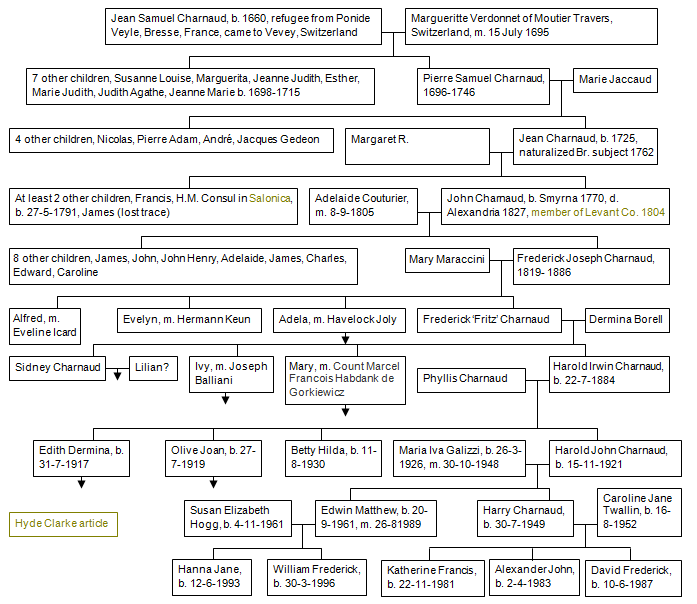 |
Simplified family tree of the Charnaud family of the Levant, based on the inherited family tree - click for a more detailed version courtesy of Nadia Giraud, 2011
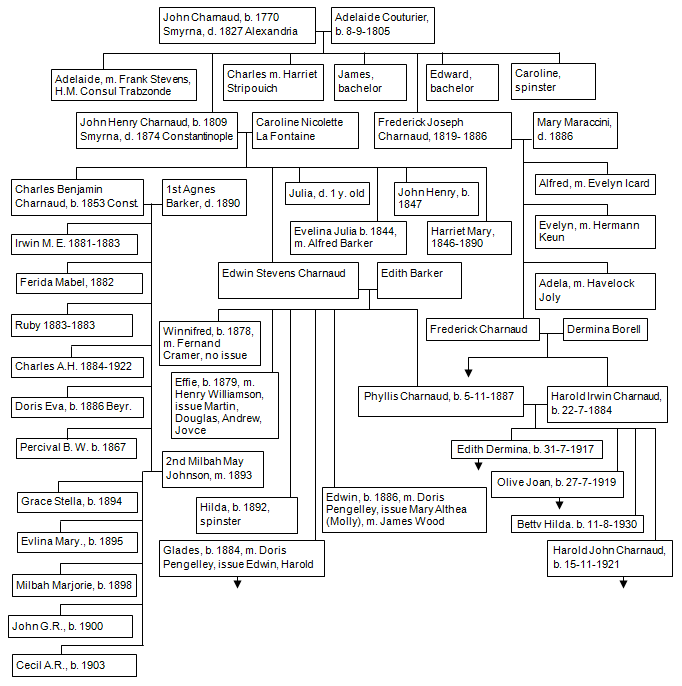 |
Simplified family tree of the Charnaud family of Smyrna / Constantinople, with increased detail on the nearer branches.
1 The Levant connection is probably through as Vevey as this town was also the temporary residence of another family of French Huguenot refugees, Morier family - info, who ended in the Levant, so perhaps there was some sort of support / information network.
2 Further information on this safe refuge during the 1922 events were provided by Edith Dermina Sell (nee Charnaud), the eldest daughter of Harold Irwin Charnaud, who as five year old accompanied her mother Phyllis, sister Olive and some aunts to stay at relations who had houses in the high ground of the Troodos in Cyprus. The relations were from the Pengelley and Williamson family with whom the Charnaud had marriage relations. After spending the summer in Cyprus, the party moved to Egypt and about a year later moved back to Turkey via Greece. A group photo received from Lewis / Williamson descendants from USA features these Smyrna refugees in Cyprus and Edith as a young girl is featured in it
Notes:
1- There is some confusion over the first name of the Charnaud Consul of Salonica during the early 19th Century. Family records were incorrect in stating Francis was the Consul in Smyrna, in fact he was in that position in Salonica as attested by the article of Hyde Clarke. Later this confusion was cleared up with the contribution (Nov. 2009) of David Wilson of Birmingham - details:
There is a collection of family burials in the Salonica cemetery of a later time, and the father’s name is given as Frederick, also buried there with the title of ‘Baron’. This would tie in with the family tree, as this name is the son of James who in turn is the son of Francis. View tombs here:
An interesting twist of history suggests (not proven) that a menial labourer employed by Consul Charnaud in Salonica eventually rose up to become the governor of Egypt, Muhammad Ali Pasha, as recorded in a book ‘Spirit of the English Magazines’:
It is clear that the Charnaud family in Salonica were successful and lived in sumptuous houses as recorded in a study by the researcher Meropi Anastassiadou in ‘Salonique 1830-1912’, where from the names mentioned we can see the upper levels of society clearly reflected the cosmopolitan mix of that city.
A recent economic history conference held in Norway, August 2008: ‘Transactions and interactions - The flow of goods, services and information’ included a presentation by an academic, Despina Vlami from the Academy of Athens, with the title of her paper: ‘British Entrepreneurship and Family Strategy in a Levantine Context: the Abbott of Salonica (18th and 19th century)’. The paper includes copious detail on the complicated relationships between the various merchants, the local British Consul Francis Charnaud (mentioned 43 times) and the Levant factory, as well as family squabbles etc., viewable here:
The same researcher also penned a study entitled ‘Entrepreneurship and relational capital in a Levantine Context: The Abbott of Salonica (18th-19th century)’ - view -, revealing further the details of the troubled tenure of the Salonica Consul Francis Charnaud and the involvement in the affairs with the Abbotts of his son (not known in family tree) James Charnaud who became British chancellor in that port city.
From the Anglican church registers of Smyrna, we see that the son of Consul Francis, John (first language clearly French as his name is Jean and entry is in that language) we know the date of marriage and name of his wife, Sarah Gala, and we see the witnesses present were the prominent Levantine merchants of Smyrna of the time.
2- More information on the Borell family my great-grandfather Frederick Charnaud married into mid 19th Century is viewable in the submission of Andrew Malleson, link above. In addition we see from the internet that the Frederick Charnaud house in Salonica is apparently still standing.
3- The parliamentary papers of 1848 show a John Charnaud was a Vice-Consul (appointed 1835) in Smyrna, date pointing to John Henry (1809 Smyrna - 1874 Constantinople), son of John.
It is likely to be this same John Charnaud who was part of the consortium to build the original Quay of Smyrna, however local intransigence almost led to the collapse of the venture, which was then picked up by the French Dussaud Brothers who finished the work in 1875, as revealed in this book segment: A recently published book ‘Smyrne et l’Occident: L’histoire intégrale d’une ville Levantine [Smyrna and the West: An integral history of a Levantine city]- Léon Kontenté - Yvelinedition, 2005, France’ also mentions this partnership which had reached agreement with the Ottoman authorities in 1867, thus by inference this John can only be John Henry one of the sons of John Charnaud.
The Smyrna Anglican Church registers show the details John Charnaud (the elder) marriage details viewable here: and that of John Henry Charnaud of Trabzon (one of the sons of John who was posted to that port city).
4- The book of Aegean Memories by Compton MacKenzie, covering the 1914-1918 war and his role in intelligence in the Aegean region, reveals a name related to this family, Archie Charnaud, possibly the same person involved in counter espionage work as recalled in the memoirs of Charles Blyth Holton. Archie Charnaud’s service record as a Royal Naval Volunteer Reserve during WWI is held at the British National Archives - details. Archie is in fact Charles Archibald Henry Charnaud, as revealed in the family tree, born 1884 Constantinople, died in France 1922, the son of Charles Benjamin Charnaud (brother of Frederick the younger) and Agnes nee Barker. It is interesting to note that the brother of “Archie”, Percival was also in the Royal Naval Volunteer Reserve force and sister Doris was a WWI war nurse and received a medal, (Fred Christian who also received a campaign medal is possibly unrelated to this family) all revealed in the British National Archives in London.
5- Fritz Charnaud is one of the players shown in the group football photo of c. 1890, and it has been confirmed by a contributor (Quentin Compton-Bishop) that this was the shortening of Frederick Charnaud married to Dermina Borell, thus making him Harry’s great-grandfather, and this footballer is clearly the same person mentioned in this article on kidnappings in Ottoman lands viewable here: and the date of 1885 would tie in if he was a boy when abducted - hover here for the article on this published in ‘The Graphic’ Saturday 31 Oct 1885.
Recently (2010) his portrait photograph was recognized in an archive Reggio family of Smyrna photo album, to which he was indirectly linked through the marriage of his daughter Ivy.
6- The Charnaud family are related to the Icard (French origin?) family by marriage, through the brother of Frederick (great-grandfather of Harry), Alfred who married Evelyn Icard - information courtesy of contributor Marie Anne Marandet: Elisabeth Marie Icard (born 26.1.1862 in Smyrna Catholic – died 2.1.1957 Karşıyaka) daughter of André Icard, merchant, & Maria Zipcy; married to Alfred Charnaud (Protestant). They lived in Karşıyaka; they had two daughters and a boy:
-Frederic Charnaud (born 21.3.1890 – died 25.1.1981) – married 7.1.1920 to Madeleine Chasseaud – 2 children Elena (b.1925) & Michel (b.1931) - more information on this couple and their story courtesy of descendant Michael Chasseaud, 2012.
-Lilian Charnaud (real name Marie Adele) born 3.6.1892 – died 1977 - married 7.3.1938 in Rhodes to Henri Frederic “Bubi” Aliotti (1893-1948).
-Lucy Charnaud born 8.9.1893 – died 1966 – married 28.6.1920 to Maurice Mainetti, son of Jacques Mainetti & Marie Ballian – 2 sons Roger (b.1922) & Frederic (b.1929).
Postcards sent from Samos in the possession of Ms. Marandet also point to a business relationship of Alfred Charnaud, as well as historic transfer of power on that island:
The postcards from Samos were sent around the years 1913-1914 by the Levantine family ‘Mainetti’ to Mrs Charnaud or to her daughters Lilian & Lucy c/o. Keun, Lavino & Co. - presumably Mr Charnaud was working for this company.
7- The same Alfred Charnaud (?) placed an advert in the 1898-1899 Indicateur Commercial [trade register] of Smyrna, indicating he was the owner of emery mines in the Pamukkale, Denizli (?) region of South-West Turkey.
8- The founder of the Women’s Royal Voluntary Service is a (nee) Charnaud, Stella Isaacs (Marchioness of Reading, 1894-1971), born in Constantinople daughter of Charles Charnaud - details. Stella is one of the youngsters featured in the photo albums of Yolande Whittall, as the Whittalls and Charnauds of the 1930s were clearly playmates in the countryside outside Istanbul (Alemdağ).
9- The events of 1922 were traumatic to all the Levantines of Smyrna and an archive letter of the time gives details of mistreatment and escape of some family names, including that of R. Charnaud (currently not identified), who was apparently a refugee in Malta with 60 [Turkish?] pounds in his pocket.
10- There is a Charnaud marriage link with the Polish origin Gorkiewicz family through Mary, sister to Phyllis and Count Marcel François Hadbank de Gorkiewicz and more details of this family are revealed through the work of Quentin Compton-Bishop in his analysis of an illuminating diary viewable here:
11- The Izmir Anglican church magazine ‘Candlesticks’ published during the 1950s records the obituary of a family member deceased, Doris Charnaud, wife of Edwin Charnaud, all buried in Bornova cemetery, including his parents, Edwin Stevens and Edith Charnaud - view tombstone. There are a total of 11 Charnaud name burials in this cemetery - view listing.
12- Grandfather Harold Irwin Charnaud seems to have had a lucky escape during the aerial bombardment of Smyrna during WWI, as recalled in the diary of Grace Williamson, here, in which his wife Phyllis also gets a brief mention for their wedding in 1916.
13- Much of the information above is mirrored on the Charnaud family web site that is being built up in conjunction with this submission and it is hoped in time the wider Charnaud family will participate in recording and preserving the cultural tapestry of this family of the past for the benefit of future generations.

